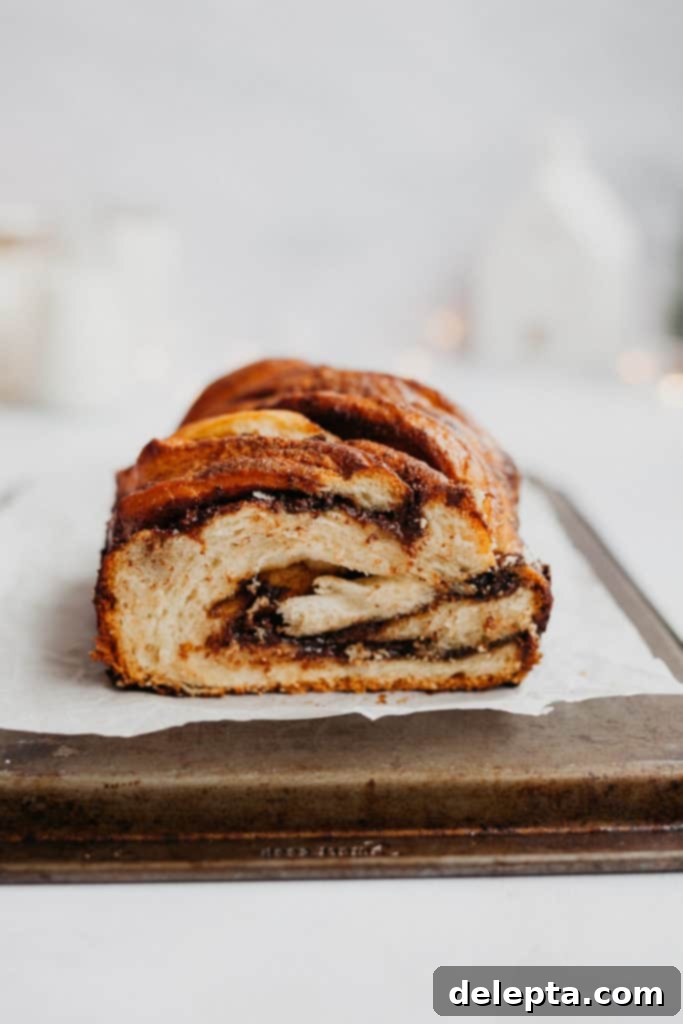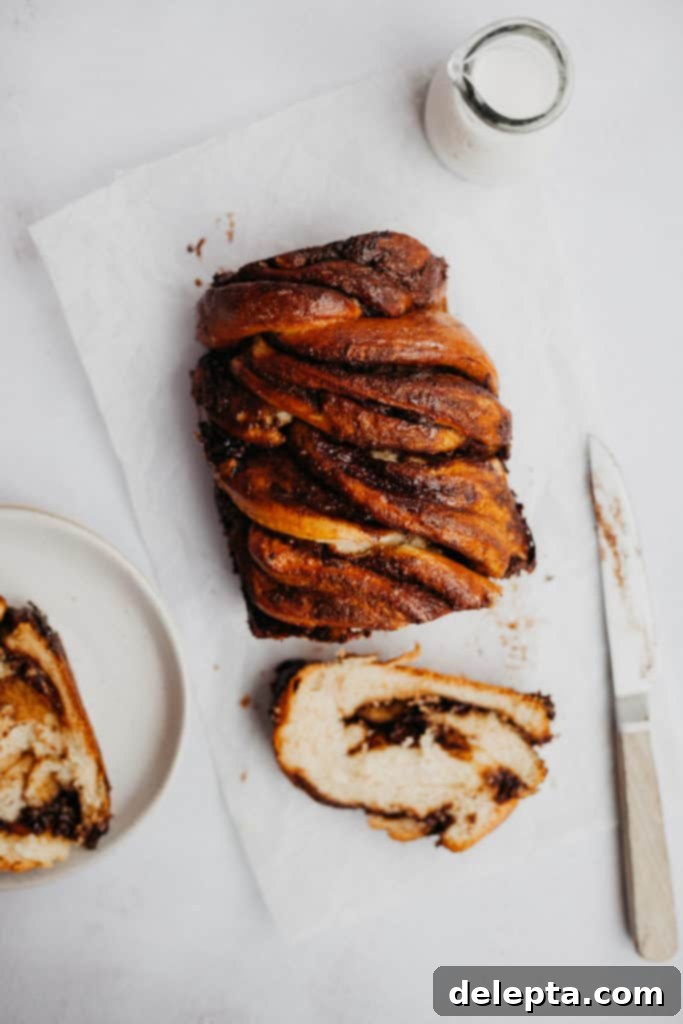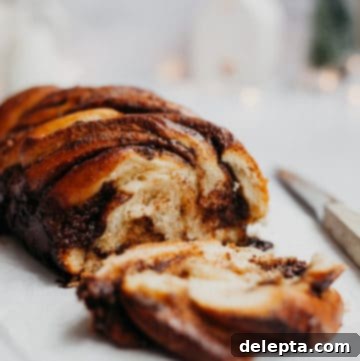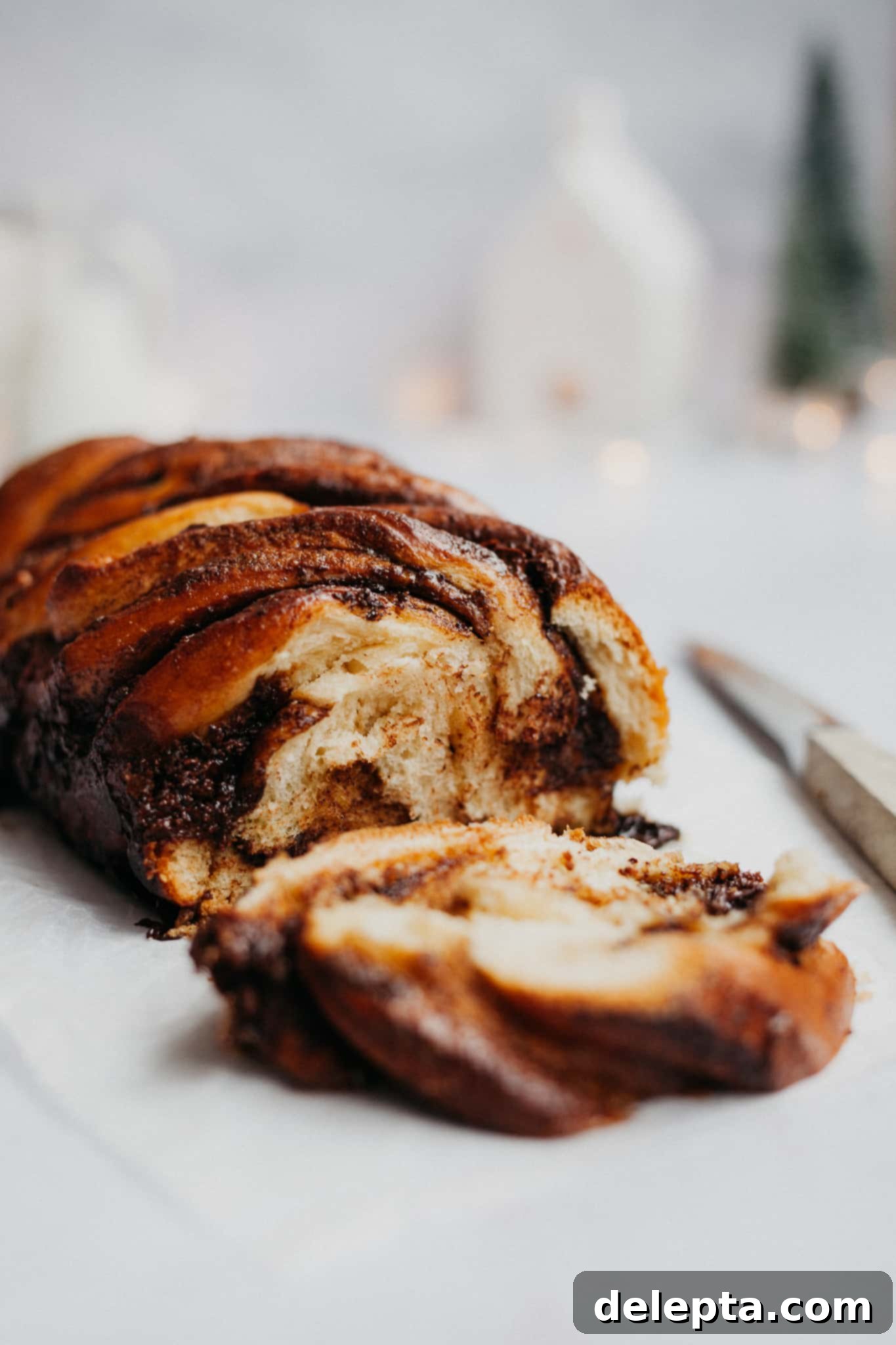Irresistible Chocolate Gingerbread Babka Recipe: Your Ultimate Holiday Baking Guide
Prepare to embark on a festive culinary journey with this truly exceptional chocolate gingerbread babka. Imagine the warmth and spice of Christmas gingerbread perfectly intertwined with the rich, comforting sweetness of dark chocolate, all nestled within a soft, fluffy, and beautifully braided babka. This recipe is a delightful fusion of cherished holiday traditions and my own Jewish heritage, much like the iconic sentiment of “2 becomes 1” by the Spice Girls. While chocolate isn’t always a traditional babka filling, I simply can’t resist sneaking in a touch of rich, chopped chocolate to elevate this holiday masterpiece!
If you’re new to the world of babka, you’re in for a treat. Babka is a sweet, braided bread or cake that holds a significant place in the culinary traditions of Polish and Ukrainian Jewish communities. Its popularity has spread far and wide, making it a beloved staple in bakeries across the United States. Whenever I find myself in New York City, a visit to my favorite bakery, Russ and Daughters, is incomplete without picking up at least one (or often two!) fresh loaves of their incredible babka. This gingerbread variation offers a festive twist on the classic, perfect for special occasions or simply to brighten a chilly morning.

Why You’ll Love This Chocolate Gingerbread Babka
This isn’t just another holiday bread; it’s an experience. The dough itself is incredibly tender and buttery, a testament to proper kneading and proofing. The gingerbread filling is a harmonious blend of warm spices like cinnamon, ginger, nutmeg, cloves, and allspice, creating an aromatic embrace that fills your kitchen with festive cheer. Then, there’s the delightful surprise of pockets of melted, chopped chocolate in every bite, adding a layer of indulgence that complements the spice beautifully. The final touch of a simple syrup glaze not only provides a gorgeous shine but also locks in moisture, ensuring your babka stays fresh and delicious. It’s truly the perfect centerpiece for your holiday breakfast, brunch, or dessert table.
FAQ & Essential Tips for Perfect Babka
Patience, my friend, is the secret ingredient here. While the total time might seem extensive, don’t be intimidated! The actual hands-on work is surprisingly minimal. Most of the time is spent waiting for the dough to rise – a crucial step that happens on three separate occasions. This waiting period is your opportunity to tackle other kitchen tasks, prepare the delicious gingerbread filling, or even catch up on an episode of Seinfeld where babka takes center stage. Embrace the pauses; they contribute to the incredible flavor and texture of the final product.
Absolutely! This recipe is designed to be flexible. You can certainly complete the entire babka-making process in a single day, enjoying a warm, freshly baked loaf for an afternoon treat. However, if you prefer to spread out the work and enhance the flavor, I highly recommend allowing the dough to rise slowly in the fridge overnight after its initial proofing. This cold fermentation develops deeper flavors and makes the dough much easier to handle when it comes to rolling and shaping. Imagine waking up to the delightful aroma of freshly baked babka for breakfast!
Ensuring your gingerbread filling is completely cool before spreading it on the dough is paramount. This step cannot be rushed! A warm or even slightly runny filling will make the dough incredibly difficult to work with. It will melt into the soft butter of the dough, causing it to tear and spill out during rolling and shaping, leading to a messy and less aesthetically pleasing babka. To speed up the cooling process, I often pop my prepared filling into the fridge for about 15-20 minutes until it’s firm enough to spread without resistance.
Yes, absolutely! While it might seem like a small, optional step, making and applying the simple syrup is incredibly important for several reasons. Firstly, it gives your babka that signature glossy, inviting shine that makes it look utterly professional and delicious. Secondly, and perhaps more importantly, the syrup soaks into the warm bread, adding an extra layer of moisture and sweetness, preventing the babka from drying out too quickly and enhancing its overall rich flavor. It’s a super easy step that yields significant rewards.

Key Ingredients & Substitutions
Creating this delicious babka relies on a few core ingredients, each playing a vital role in achieving its perfect texture and flavor. Here’s a closer look at what you’ll need and why:
- Yeast: Essential for that lovely rise and airy texture. Ensure your yeast is fresh and active. You can test it by mixing a small amount with warm water and a pinch of sugar; if it bubbles after 5-10 minutes, it’s good to go. I typically use active dry yeast, but instant yeast can also be used – just mix it directly with the dry ingredients.
- Flour: This recipe calls for regular all-purpose flour, rather than bread flour. All-purpose flour yields a softer, more cake-like crumb, which is characteristic of traditional babka. When measuring, always spoon the flour into your measuring cup and level it off with a straight edge to avoid over-packing, which can result in a dense babka.
- Treacle: To achieve that deep, authentic gingerbread taste and rich color, I highly recommend using treacle. It offers a more complex, slightly bitter caramel note compared to molasses. However, if treacle is unavailable, you can confidently substitute it with an equal amount of dark molasses for a similar effect.
- Spices: A carefully selected mix of ground spices is what gives this babka its signature warm, spicy, and inviting holiday aroma. My blend includes a generous combo of cinnamon, allspice, nutmeg, cloves, and ginger. Feel free to adjust the quantities to your personal preference, adding a little more ginger for an extra kick or more cinnamon for a sweeter spice profile. You can also use a pre-made gingerbread spice mix if you have one on hand.
- Unsalted Butter: Used generously in both the dough and the filling, butter contributes to the babka’s rich flavor and tender texture. Using unsalted butter allows you to control the total salt content in the recipe. Make sure your butter is at room temperature for the dough, as this helps it incorporate smoothly.
- Granulated Sugar & Light Brown Sugar: A combination of these sugars provides balanced sweetness and moisture. Granulated sugar offers crisp sweetness, while light brown sugar adds a subtle caramel note and helps keep the babka moist.
- Whole Milk & Water: These liquids hydrate the dough and activate the yeast. Using whole milk adds richness and softness to the babka dough.
- Vanilla Extract: A touch of vanilla extract enhances all the other flavors, adding a comforting aromatic depth to the dough.
- Eggs: Eggs contribute to the babka’s structure, richness, and golden color. Ensure they are at room temperature for optimal incorporation into the dough.
- Kosher Salt: A pinch of salt is crucial for balancing the sweetness and enhancing the overall flavor of the babka.
- Chopped Chocolate: While gingerbread is the star, the chopped chocolate is the irresistible co-star. Use good quality dark or semi-sweet chocolate for the best results, as it will melt beautifully into pockets of deliciousness within the babka.
Other Festive Recipes to Try
If you’re in the mood for more delightful baking, explore these other fantastic recipes perfect for any occasion:
- Cheesecake Swirl Pumpkin Bread
- Cinnamon Roll Muffins
- Cranberry Lemon Loaf
Chocolate Gingerbread Babka Recipe

Chocolate Gingerbread Babka
Ella Gilbert
Pin Recipe
Save RecipeSaved!
Equipment
-
1 loaf pan (standard 9×5 inch is ideal)
Ingredients
Babka Dough
- 310 grams all-purpose flour (plus extra for dusting)
- 38 grams granulated sugar
- 1 ½ teaspoon active dry yeast (ensure it’s fresh and active)
- 1 teaspoon kosher salt
- 60 grams warm water (approx. 105-115°F / 40-46°C)
- 60 grams whole milk (warm, approx. 105-115°F / 40-46°C)
- 60 grams unsalted butter (melted and slightly cooled)
- ½ teaspoon vanilla extract
- 1 large egg (room temperature)
Egg Wash
- 1 large egg
- 15 grams water
Gingerbread Filling
- 42 grams unsalted butter (melted)
- 40 grams light brown sugar
- 20 grams granulated sugar
- 20 grams treacle (or dark molasses)
- 1 ½ teaspoon ground cinnamon
- ⅛ teaspoon ground nutmeg
- ⅛ teaspoon ground cloves
- 1 teaspoon ground ginger
- ¼ teaspoon ground allspice
- 64 grams chopped chocolate (dark or semi-sweet)
Simple Syrup
- 20 grams granulated sugar
- 18 grams water
Instructions
-
In the large bowl of a stand mixer, fitted with the paddle attachment, combine 125g of the all-purpose flour along with the yeast, 38g granulated sugar, and kosher salt. Whisk these dry ingredients together thoroughly to ensure even distribution.
-
In a separate microwave-safe bowl or a small saucepan over medium-low heat, gently warm 60g water, 60g whole milk, 60g melted unsalted butter, and ½ tsp vanilla extract until the mixture is warm to the touch (105-115°F or 40-46°C). Pour this warm liquid mixture into the stand mixer bowl with the dry ingredients. Beat on low speed until just combined. Add the room temperature egg and continue mixing on low until fully incorporated. Finally, add the remaining 185g of all-purpose flour and beat on low speed until the mixture is just combined and no dry streaks of flour are visible. The dough will still be quite sticky at this stage.
-
Switch the paddle attachment to the dough hook attachment. Knead the dough on a medium-low speed for 5-7 minutes. During this time, the dough should gradually begin to pull away from the sides of the bowl, though it will remain somewhat sticky to the touch. If the dough doesn’t quite pull away, you may add up to 1 extra tablespoon of flour, one teaspoon at a time, until the desired consistency is reached. The goal is a soft, pliable, and slightly tacky dough.
-
Lightly flour a clean work surface. Scrape the dough out onto it. Perform a series of “stretch and folds” to further develop gluten and create a superior crumb structure. To do this, grab the top portion of the dough, gently pull it upwards, and then fold it over towards the middle of the dough ball. Give the dough a quarter turn and repeat this process until you have completed 4 stretch and folds. While not strictly mandatory, this technique will significantly contribute to a softer and fluffier babka.
-
Lightly oil your stand mixer bowl (or a clean, large bowl) with a neutral oil or non-stick spray. Place the kneaded dough inside, turning it once to coat all sides lightly. Cover the bowl tightly with plastic wrap to prevent a skin from forming. Let the dough rise in a warm, draft-free place for approximately 45 minutes, or until it has visibly doubled in size.
-
Once the dough has risen, gently scrape it back onto a lightly floured surface. Using your fingers or a rolling pin, gently press or roll the dough into a rectangle approximately 8×6 inches. Wrap this rectangle tightly in plastic wrap and transfer it to the refrigerator for at least one hour. For enhanced flavor development and easier handling (as cold dough is less sticky and more elastic), I highly recommend chilling it overnight.
-
While your dough is chilling, prepare the gingerbread filling. In a small saucepan over medium-low heat, or in a microwave-safe bowl, melt the 42g unsalted butter together with the 20g treacle (or molasses) until smooth and well combined. Remove from heat and stir in the 40g light brown sugar, 20g granulated sugar, 1½ tsp ground cinnamon, ⅛ tsp ground nutmeg, ⅛ tsp ground cloves, 1 tsp ground ginger, and ¼ tsp ground allspice. Mix thoroughly until all ingredients are incorporated and the mixture is smooth. Set aside and allow the filling to cool completely to room temperature (or even chill briefly in the fridge) before using. A warm filling will make the dough difficult to roll.
-
Prepare your loaf pan (standard 9×5 inch). Generously grease the inside of the pan with butter or baking spray. Then, line the pan with a strip of baking parchment paper, leaving an overhang on the longer sides. This overhang will act as “handles” to easily lift the babka out of the pan after baking.
-
On a lightly floured surface, unwrap your chilled dough. Roll it out into a large rectangle, approximately 13×10 inches (33×25 cm). Use a pastry brush or a small offset spatula to evenly spread the cooled gingerbread filling over the entire surface of the dough, making sure to leave a ½-inch (1.25 cm) border clear along all edges of the rectangle. Sprinkle the 64g of chopped chocolate evenly over the filling.
-
Starting from one of the longer sides, tightly roll up the dough into a neat cylinder. Take your time to roll it as tightly as possible to ensure beautiful swirls in the baked babka. Once rolled, carefully lift the cylinder and gently pull each end to stretch it slightly until it measures about 14 inches (35 cm) in length. With the seam of the cylinder facing downwards, use a sharp bread knife to carefully cut the cylinder in half lengthwise, creating two long strips. Now, take one strip and lay it over the other, forming an “X” shape, ensuring the cut, filling-side is facing upwards for maximum visual appeal. Twist the upper half of the “X” twice, then twist the lower half twice, creating a braided effect. Pinch the ends firmly together to seal them. Carefully transfer this braided dough into your prepared loaf pan, tucking the ends neatly underneath to create a tidy finish.
-
Cover the loaf pan loosely with plastic wrap or a clean kitchen towel. Allow the babka to rise in a warm, draft-free place for another 30 minutes to 1 hour. The exact rising time will depend on how long the dough was chilled and the warmth of your kitchen. To test if it’s ready for baking, gently press your finger into the surface of the dough. The dough should spring back slightly but still leave a visible indentation – this is known as the “finger dent test” and indicates it’s perfectly proofed.
-
While the babka is completing its final rise, preheat your oven to 350°F (180°C). In a small bowl, whisk together the remaining egg and 15g water to create an egg wash. Once the babka has passed the finger dent test, use a pastry brush to gently and evenly brush the egg wash over the entire top surface of the dough. This will give it a beautiful golden-brown crust.
-
Bake the babka in the preheated oven for 45-50 minutes, or until it’s beautifully golden brown on top and cooked through. A wooden skewer inserted into the center should come out clean. While the babka is baking, prepare your simple syrup: combine 20g granulated sugar and 18g water in a microwave-safe bowl or a small saucepan. Heat over medium heat or in the microwave until the sugar has completely dissolved and the syrup is clear. Let the simple syrup cool completely before using.
-
Once the babka is removed from the oven, immediately brush the cooled simple syrup generously over its hot surface. This will create that gorgeous shine and help keep the babka moist. Allow the babka to cool in the pan for at least an hour before carefully lifting it out using the parchment paper handles and slicing. Cooling completely ensures the filling is set and the structure is firm for clean cuts.
Nutrition
